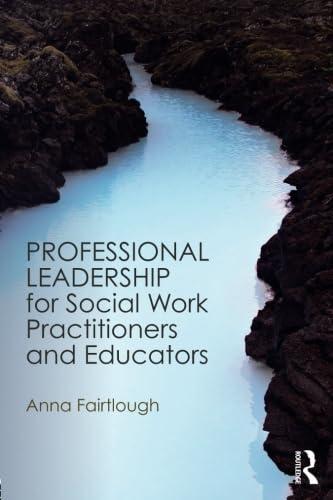An independent inquiry found that at least 1,400 young people had been sexually exploited between 1997 and
Question:
An independent inquiry found that at least 1,400 young people had been sexually exploited between 1997 and 2013 in Rotherham, Yorkshire. The inquiry highlights the systematic grooming of vulnerable young women, and some young men, and their appalling experiences of abuse and violence. A small group of front-line workers had consistently raised concerns about CSE in the borough from the late 1990s onwards, and since then there had been growing research and practice evidence of the scale and severity of the problem. The report concludes that until 2009 there was a collective failure of senior managers from children’s social care and the police and local politicians to respond adequately to these mounting concerns.
The report found that the agencies involved had adopted sound policies and procedures (i.e. their espoused theories), which acknowledged the existence of and the potential physical, emotional and psychological harm from CSE, held abusers accountable for their actions and asserted that young people were entitled to protection.
However, in practice, these espoused theories were often not followed through. The theories-in-use by senior police officers and social care managers more often appeared to deny that the abuse could be as bad as was being reported and to place disproportionate responsibility for the abuse on the young people rather than on the abusers. Young women in particular were perceived as troublesome, deviant and promiscuous and to be choosing to participate in relationships with their abusers.
As in Argyris, Putnam and Smith’s (1985) type 1 organisations, defensiveness often characterised the responses of senior managers and politicians. A striking example of this is the personal hostility displayed towards Dr Heal, a government researcher, who, in a series of reports that were distributed to middle and senior managers in all key agencies, had uncovered alarming links among sexual exploitation, violence and drug crime. Although these reports highlighted areas of good practice, examples of poor practice and negative attitudes were more widespread. These included failure to act on a detailed ‘mapping exercise’ cross-referencing data on victims and perpetrators and a pervasive lack of awareness of and interest in CSE. Senior officers in the police and the council appeared to believe that parts of the report had been exaggerated or fabricated, did not seriously inquire into the evidence provided and prevented the researcher from completing the project. Jay (2014, p. 89) concludes that had this research ‘been treated with the seriousness it merited … the children involved then and later would have been better protected and abusers brought to justice’.
The inquiry found that there had been few organisational systems to learn from cases of CSE that had gone wrong. It concludes that this had contributed to continuing poor practice. There were complicated issues of gender and ethnicity. Instances of a bullying, ‘macho’ culture within the council and amongst senior officers were reported. Jay (2014, p.
115) comments that this ‘is likely to have impeded the Council from providing an effective, corporate response to such a highly sensitive social problem as child sexual exploitation’. Many of the examples of CSE involved white girls and Pakistani-heritage men. However, officers and politicians seemed uncomfortable with open discussion of this, perhaps concerned with being seen to be racist. There had been little attempt to engage the Pakistani community, particularly women’s groups, in discussions about CSE. Since 2009, Jay found that there had been a push to raise awareness about CSE and to develop better systems to protect children and prosecute abusers. However, she highlighted that continuing financial pressure on the Council is undermining its capacity to respond effectively to CSE.
Step by Step Answer:

Professional Leadership For Social Work Practitioners And Educators
ISBN: 9781472467539
1st Edition
Authors: Anna Fairtlough





